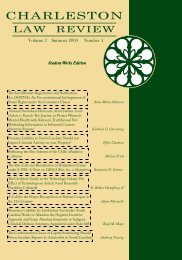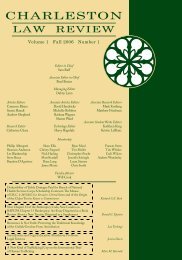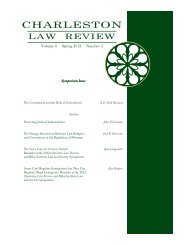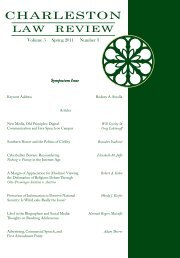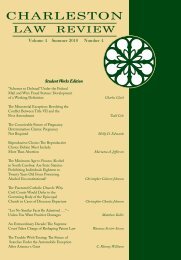Volume 5 Winter 2011 Number 2 - Charleston Law Review
Volume 5 Winter 2011 Number 2 - Charleston Law Review
Volume 5 Winter 2011 Number 2 - Charleston Law Review
Create successful ePaper yourself
Turn your PDF publications into a flip-book with our unique Google optimized e-Paper software.
<strong>2011</strong>] Errors in Judgment3. Adversary Proceedings to Determine Dischargeability ofStudent Loans 32In the course of an adversary proceeding to determinedischargeability of a student loan, the relevant inquiry requiredby the Code, as noted earlier, is to ascertain whether the debtorwould suffer an “undue hardship” unless relieved of theobligation to pay the student loan, along with other debts thedebtor is allowed to discharge in the bankruptcy proceeding. 33When faced with the question of how to prove undue hardship inan adversary proceeding, courts have not always been consistent,particularly since such determinations inherently depend on thefacts. 3432. Student loans are no small matter. According to a previewer of theEspinosa case then pending before the United States Supreme Court:The Espinosa drama unfolds against the backdrop of high valuestudent loan markets and high volume consumer bankruptcy dockets.According to amici curiae briefs filed by the Educational CreditManagement Corporation (ECMC) and the National Council of HigherLoan Programs (NCHELP), which operate or represent student loanorganizations, the total value of loans in the two federally supportedstudent loan programs as of September 2007 is approximately $500billion.Ferve E. Ozturk, Supreme Court Preview: United Student Aid Funds Inc. v.Espinosa, AM BANKR.INST.J., Sept. 2009, at 40, 41.33. 11 U.S.C. § 523(a) (2006). It is worth noting that the passage of theHigher Education Amendments of 1998, Pub. L. No. 105-244, eliminated theseven year “safe harbor” provision that had previously existed so that virtuallyall students loans are now nondischargeable absent a finding of unduehardship. Thomas Yerbich, Discharge of Student Loans: A Quandary, 23ALASKA BAR RAG 11, 11 (1999). Moreover, the Bankruptcy Abuse Preventionand Consumer Protection Act of 2005 (BAPCPA), Pub. L. No 109-8, § 220, 119Stat. 23, 59 (codified at 11 U.S.C. § 523(a)(8)(B)) amended the Code in 2005 toinclude most private students loans as among the types of student loans thatcannot be discharged absent proving undue hardship. Before the passage ofBAPCPA, these private student loans were automatically dischargeable inbankruptcy just as most other types of debts. See 11 U.S.C. § 523(a)(8); see alsoTestimony of Rafael I. Pardo, AM.BANK.INST.J.,Nov. 2009, at10, 10.34. See Anthony P. Cali, Note, The “Special Circumstance” of Student LoanDebt Under the Bankruptcy Abuse Prevention and Consumer Protection Act of2005, 52 ARIZ.L.REV. 473, 479 (2010).Although more than one test exists for determining unduehardship, the Brunner test has become the most widely accepted. . . .201



